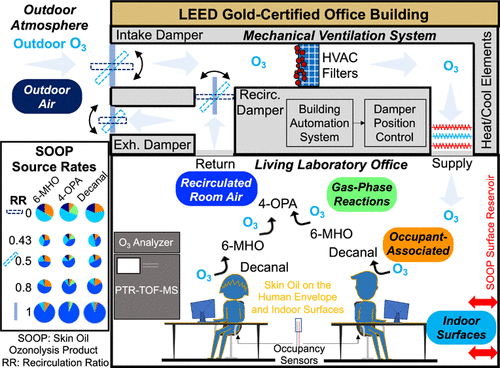当前位置:
X-MOL 学术
›
Environ. Sci. Technol.
›
论文详情
Our official English website, www.x-mol.net, welcomes your
feedback! (Note: you will need to create a separate account there.)
Influence of Mechanical Ventilation Systems and Human Occupancy on Time-Resolved Source Rates of Volatile Skin Oil Ozonolysis Products in a LEED-Certified Office Building
Environmental Science & Technology ( IF 10.8 ) Pub Date : 2021-12-01 , DOI: 10.1021/acs.est.1c03112 Tianren Wu 1, 2 , Antonios Tasoglou 3 , Heinz Huber 4 , Philip S Stevens 5, 6 , Brandon E Boor 1, 2
Environmental Science & Technology ( IF 10.8 ) Pub Date : 2021-12-01 , DOI: 10.1021/acs.est.1c03112 Tianren Wu 1, 2 , Antonios Tasoglou 3 , Heinz Huber 4 , Philip S Stevens 5, 6 , Brandon E Boor 1, 2
Affiliation

|
Building mechanical ventilation systems are a major driver of indoor air chemistry as their design and operation influences indoor ozone (O3) concentrations, the dilution and transport of indoor-generated volatile organic compounds (VOCs), and indoor environmental conditions. Real-time VOC and O3 measurements were integrated with a building sensing platform to evaluate the influence of mechanical ventilation modes and human occupancy on the dynamics of skin oil ozonolysis products (SOOPs) in an office in a LEED-certified building during the winter. The ventilation system operated under variable recirculation ratios (RRs) from RR = 0 (100% outdoor air) to RR = 1 (100% recirculation air). Time-resolved source rates for 6-methyl-5-hepten-2-one (6-MHO), 4-oxopentanal (4-OPA), and decanal were highly dynamic and changed throughout the day with RR and occupancy. Total SOOP source rates during high-occupancy periods (10:00–18:00) varied from 2500–3000 μg h–1 when RR = 0.1 to 6300–6700 μg h–1 when RR = 1. Source rates for gas-phase reactions, outdoor air, and occupant-associated emissions generally decreased with increasing RR. The recirculation air source rate increased with RR and typically became the dominant source for RR > 0.5. SOOP emissions from surface reservoirs were also a prominent source, contributing 10–50% to total source rates. Elevated per person SOOP emission factors were observed, potentially due to multiple layers of soiled clothing worn during winter.
中文翻译:

机械通风系统和人员占用对 LEED 认证办公楼中挥发性皮肤油臭氧分解产物的时间分辨源率的影响
建筑机械通风系统是室内空气化学的主要驱动力,因为它们的设计和运行会影响室内臭氧 (O 3 ) 浓度、室内产生的挥发性有机化合物 (VOC) 的稀释和迁移以及室内环境条件。实时 VOC 和 O 3测量结果与建筑物传感平台相结合,以评估机械通风模式和人员占用对冬季 LEED 认证建筑物办公室皮肤油臭氧分解产品 (SOOP) 动态的影响。通风系统在从 RR = 0(100% 室外空气)到 RR = 1(100% 再循环空气)的可变再循环比 (RR) 下运行。6-甲基-5-庚烯-2-酮 (6-MHO)、4-氧代戊醛 (4-OPA) 和癸醛的时间分辨源率是高度动态的,并且全天随 RR 和入住率而变化。当 RR = 0.1 到 6300-6700 μg h -1时,高入住期间(10:00-18:00)的总 SOOP 源率从 2500-3000 μg h -1变化当 RR = 1 时。气相反应、室外空气和与乘员相关的排放物的源速率通常随着 RR 的增加而降低。再循环空气源率随着 RR 的增加而增加,并且通常成为 RR > 0.5 的主要来源。来自地表水库的 SOOP 排放也是一个重要来源,占总排放量的 10-50%。观察到人均 SOOP 排放因子升高,这可能是由于冬季穿了多层脏衣服。
更新日期:2021-12-21
中文翻译:

机械通风系统和人员占用对 LEED 认证办公楼中挥发性皮肤油臭氧分解产物的时间分辨源率的影响
建筑机械通风系统是室内空气化学的主要驱动力,因为它们的设计和运行会影响室内臭氧 (O 3 ) 浓度、室内产生的挥发性有机化合物 (VOC) 的稀释和迁移以及室内环境条件。实时 VOC 和 O 3测量结果与建筑物传感平台相结合,以评估机械通风模式和人员占用对冬季 LEED 认证建筑物办公室皮肤油臭氧分解产品 (SOOP) 动态的影响。通风系统在从 RR = 0(100% 室外空气)到 RR = 1(100% 再循环空气)的可变再循环比 (RR) 下运行。6-甲基-5-庚烯-2-酮 (6-MHO)、4-氧代戊醛 (4-OPA) 和癸醛的时间分辨源率是高度动态的,并且全天随 RR 和入住率而变化。当 RR = 0.1 到 6300-6700 μg h -1时,高入住期间(10:00-18:00)的总 SOOP 源率从 2500-3000 μg h -1变化当 RR = 1 时。气相反应、室外空气和与乘员相关的排放物的源速率通常随着 RR 的增加而降低。再循环空气源率随着 RR 的增加而增加,并且通常成为 RR > 0.5 的主要来源。来自地表水库的 SOOP 排放也是一个重要来源,占总排放量的 10-50%。观察到人均 SOOP 排放因子升高,这可能是由于冬季穿了多层脏衣服。











































 京公网安备 11010802027423号
京公网安备 11010802027423号